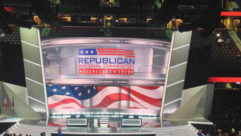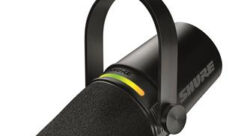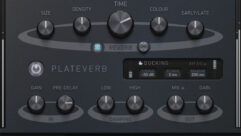Battling Reverb
Mar 1, 2003 12:00 PM,
Peter Mapp
One of the most important goals of any speech reinforcement or P.A. system is to relay intelligible speech or announcements to the listeners. Other factors such as sound quality, naturalness, and localization are also important, but intelligibility is the overriding goal. Numerous factors can get in the way of achieving adequate intelligibility and clarity, ranging from poor microphone technique to poor system operation. However, at the design stage, there are essentially two primary factors relating to the building or space itself that need to be taken into account: noise and reverberation. In many cases, the sound system designer may have little influence over these limiting factors but has to design around or against them. It somewhat trivializes the situation to say that all you have to do to overcome the background noise is turn the level up, but in essence that is what is required. Therefore, as long as the system can produce enough sound level and assuming you do not end up at megadecibel levels bordering on the threshold of pain, suitable adjustment of the system gain control should do the trick. Reverberation, however, is a completely different intelligibility destroyer that, of course, depends directly on the acoustics of the building. It is still staggering to find that many sound systems fail to deliver intelligible sound solely because of a lack of understanding of the basic effects of reverberation and late reflections.
Reverberation is one of the oldest acoustic parameters to be identified, with well-documented evidence of this dating back more than 2,000 years. Yet it was only 100 years ago that Sabine quantified the mathematical relationship that led to the ability to predict it. Within the past several years, certain imaging techniques have been developed to “see” reverberation in a space (see Fig. 1). So why, with a hundred years of experience and the development of new research tools, are reverberant buildings still such a problem? True, people have been attempting to install sound systems into them for only around 80 years, but as early as 1923, the problem of reverberation relating to sound systems was being written about, and by 1934 solutions were quite well understood. Whereas from a purely scientific or engineering point of view it might seem logical to treat the cause of the problem at the source — for example, make the room less reverberant — in practice this often is not even a remotely possible or practical solution. However, in many cases not treating the room will put an irrevocable limitation on the final intelligibility that it is possible for the system to achieve. Available budget, of course, also plays a significant role. The implications of acoustics and budget, however, are quantifiable and should be determined so that their impact can be passed on to the client or end-user as early as possible. So how do you go about beating the reverberation barrier? Can audio technology provide a solution to overcome the acoustics of any potential space? For that matter, is all reverberation a bad thing, and when does it become problematic?
The table, “Potential Effect of Reverberation Time on System Intelligibility,” gives a brief indication of when potential problems may arise when using a sound system in an enclosed space. However, reverberation time (RT) is not the sole determining factor of the problem; as you shall see, room volume, size, and shape of the space, as well as the number of loudspeakers and their directivity characteristics, all affect the reverberant field and overall system intelligibility.
Fig. 2 shows a measurement of intelligibility (STI) versus the distance from the sound source — in this case, a single, low directivity, loudspeaker in a large reverberant church (RT of 3.5 seconds, midfrequency average).
As you can see, intelligibility is clearly a function of the distance between source and receiver, though this is a nonlinear relationship. Plotting the curve as the log of distance produces a straight-line graph and shows intelligibility to be a function of distance squared up to a certain point; where it flattens out is effectively constant. In other words, intelligibility follows the inverse square law until limited by the reverberant field of the room or space.
The potential intelligibility at a given distance in a reverberant space can be estimated from the simple %ALCONS formula. This relates the loudspeaker-to-listener distance, reverberation time (T60), and volume of the space together with the directivity (Q) of the loudspeaker to effectively calculate the direct-to-reverberant ratio, and then relates this to an intelligibility scale. A further term (n+1), which takes into account the number of other loudspeakers operating in the space and contributing to reverberant field (thereby reducing the direct-to-reverberant ratio), is also included in the overall formula.
%ALCONS = 200 D2 (T60)2 (n + 1)/QV (metric units)
or
%ALCONS = 656 D2 (T60)2 (n + 1)/QV (American)
The %ALCONS scale is an inverted one; the smaller the number, the greater the intelligibility. The formula therefore indicates that the intelligibility of a loudspeaker in a given space can be improved by increasing the volume or by making the loudspeaker more directional (a greater value of Q). Conversely, intelligibility is decreased by increasing the listener-to-loudspeaker distance or by longer reverberation times. Both of these latter factors follow a square law relationship, and so a relatively small change in distance or reverberation time can have a significant effect on intelligibility. Although the %ALCONS formula is simple in its approach and can be readily used to predict potential intelligibility, this is also its downfall, because it is also highly inaccurate.
This is demonstrated in Figs. 3 and 4, which illustrate the measured STI and predicted %ALCONS converted to STI of a single loudspeaker as a function of distance in another highly reverberant space. In Fig. 3, you again see the characteristic nonlinear decrease of intelligibility with distance.
In the previous example, the measured curve shows some deviation from a squared distance function because of the presence of discrete reflections from the seating and curved walls. In Fig. 4, the measured curve is compared with three prediction methods. The red uppermost curve is the simple %ALCONS formula, which clearly makes a poor attempt of predicting the measured result. The simple formula exhibits a completely different curve shape that does not track the measured data. The lower black and light blue curves, which are based on the more complex form of the %ALCONS formula, make a better approximation to the shape of the measured curve but still significantly underpredicts the performance of the loudspeaker. Clearly, caution is required when using such simple statistical mathematical methods, but the more complex curves more accurately predict the curve shape and transition into the reverberant field.
Reverberation is most problematic in churches, because of the critical importance of speech communication. Churches occur in many shapes and sizes and exhibit widely differing acoustics. In Europe traditional churches often date back many hundreds of years and are generally of stone construction. Stone, although a wonderful material offering a distinct texture and enabling awe-inspiring architecture to be created, is not known for its sound-absorbing properties. As a result, many of Europe’s traditional churches reflect this in their acoustics, exhibiting long or very long reverberation times. Although small churches may have tolerable values of around 1.5 seconds, slightly larger ones, those capable of seating around 200 to 300 people, often have midfrequency reverberation times of around 2.5 seconds. Cathedrals, generally with marble floors and rarely a padded pew in sight, rate even higher on the reverberation scale and tend to hang onto their sound for typically 4 to 6 seconds, before eventually letting it die away. Then there are the truly magnificent buildings that exhibit reverberation times of between 9 and 11 seconds, or 13 seconds in the case of St. Paul’s Cathedral in London. Dealing with long reverberation times can be a challenging occupation, though some of the tools and techniques now available to the modern sound system designer have helped to tame the reverberation barrier.
Essentially, there are three basic approaches to providing speech reinforcement in these types of spaces: 1. using a point source, high-Q array that attempts to cover the area from a single location (although split, high-Q clusters also fit into this category); 2. distributed systems using devices with medium directivity in a limited number of locations to cover the audience or congregation; and 3. high-density distributed systems, where multiple loudspeakers are employed to cover the area and where overlapping between devices is encouraged in order to maintain a consistent direct-reflected energy ratio. I will take a look at each of these approaches in turn and also see where each is applicable or, more importantly, where the technique will most definitely not work.
In the more compact or diffuse buildings with reverberation times up to around 1.2 seconds, one has to struggle to produce poor quality and unintelligible sound. That it not to say that it cannot be done — far from it. However, even a vaguely competent designer has a range of choices in this essentially benign environment. Indeed, the primary purpose of a sound system in such buildings is just to make the sound louder; the natural voice on its own is often intelligible enough; it just needs amplifying.
The size of the room and its total internal volume are crucial factors to the success of any sound system. In a relatively small worship space (100 to 150 people), the volume and proximity of the sidewalls and ceiling are likely to produce a high degree of useful early reflections while the reverberant contribution is controlled by the relatively short reverberation time of the space. In other words, a high ratio of early-to-late sound is produced, as indicated by a positive C50 value (C50 is the ratio of the total sound energy arriving within the first 50 ms to the total sound energy, including the total direct and reverberant sound fields). The reverberation time of a space, by itself, is not necessarily a good indicator of potential intelligibility.
As an illustration, I was recently involved in assessing the performance of the sound systems in three traditional U.K. churches. The first was a building dating back to 1361. Although the nave ceiling was relatively high, at around 30 to 35 feet, the nave itself was fairly narrow and very diffuse, with regular pillars and upper walls that provided a good density of early reflections. Natural intelligibility was good, and it was surprising to later find that the reverberation time was around 2.5 seconds. This building therefore provided considerable flexibility for installing a discrete sound system; small and visually unobtrusive loudspeakers of low directivity could be employed without significant compromise to the potential intelligibility. Also, the type of service practiced did not require fast speech or wide-ranging and dynamic music to be amplified, again lessening the challenge.
That was not the case for two other traditional churches of around the same capacity (approximately 200 people) and dating back to the 1830s. In this instance, although they had carpeted floors and more modern decor, obtaining adequate intelligibility was much more difficult, despite the fact that they also exhibited reverberation times of around 2.5 seconds. Although the ceilings were not as high, the buildings were wider so that far fewer lateral reflections and useful early energy could be produced. While the spaces did not sound particularly reverberant, natural unamplified speech was difficult to understand. Here distributed medium-Q devices (a Q of around 15 to 18) were required in order to provide adequate coverage and intelligibility. These buildings were deceptive and required a fairly detailed acoustic survey to be carried out before a design could be started.
Once the reverberation time reaches around 3.5 seconds, there is rarely any doubt that you are in a reverberant space, and the battle for intelligibility begins. The design goals are to aim for as high a direct-to-reverberant ratio as you can, point the loudspeakers at the people, and keep as much sound as possible from striking the walls or other large reflecting surfaces. In other words, try to produce as much useful sound as possible and avoid exciting the reverberant field. This immediately suggests the use of directional loudspeakers.
The %ALCONS formulas are a good starting place to check out a potential design, but their inherent inaccuracies must not be overlooked. Furthermore, the (n + 1) factor is often misunderstood but essentially shows that other loudspeakers operating in the same space act to degrade the overall intelligibility by adding energy to the reverberant field. However, determining the n factor is not always as precise as might be thought, because a proportion of this reverberant energy (arriving at the listening position within 35 to 50 ms) can be potentially useful and aid intelligibility by increasing the direct and early sound components.
Line arrays are finding a resurgence of interest for dealing with reverberant spaces, though their use in such environments dates back more than 50 years (11-foot-high, two-way units were used in St. Paul’s Cathedral way back in 1952). The ability of the current generation of digital signal-processing-controlled line arrays to cut through six-second-plus reverberation times is truly awesome. With such devices, many churches and reverberant spaces are able to reproduce the ethereal long reverberation times that can make the spine tingle with some forms of choral and organ music while also enjoying the benefits of highly intelligible speech. Fig. 5 shows the intelligibility (STI) falloff with distance for a Duran model Ivx-6c line array in a large 4-second RT church, set to radiate with a vertical beamwidth of just 4 degrees. Note the almost constant STI value, indicating a steady D/R ratio with distance.
The installation of these devices may not always be possible, of course, because of architectural or financial reasons. An alternative is to use a distributed system of medium-to-high Q devices (Q of around 30). Such an example is shown in Fig. 6. This is a highly reverberant 3.5 second RT60 church, with hard plastered walls and ceiling. The upper walls and ceiling are also curved for good measure. Specular reflections abound, making this a challenging space. Six high-quality, four-foot-high line source loudspeakers were employed, and an even distribution of intelligible sound was achieved, as shown in the prediction coverage plot in Fig. 7, which shows the unoccupied condition with an average predicted RaSTI of 0.5 (10% ALCONS). The prediction agreed well with measurements on the completed system. When occupied, the RaSTI was expected to increase to around 0.6 STI (approximately 6% ALCONS). The loudspeaker solution for this church relied on the fact that architectural columns happened to be located in useful positions to mount the loudspeakers.
This is not always the case, and in some cases, the only viable solution may be to install a high-density pewback loudspeaker system. By mounting small, low-directivity loudspeakers to the back of the pews facing back at the congregation, the distance between listener and loudspeaker is minimized, perhaps being no more than 2 to 3 feet. However, the trade-off is the large number of loudspeakers required. Typically one loudspeaker is shared between every two listeners. The (n + 1) factor or number of loudspeakers contributing to the reverberant field can be become large and could easily exceed 100 to 200 in even a medium-size church. If carefully designed, such installations can work well and can be visually unobtrusive. However, many pewback installations fail because too few loudspeakers were employed or were located where the congregation would actually block sound distribution. The loudspeakers should also be angled/directed toward the listeners and not fire directly into their kneecaps. A recent approach using this technique has been to use flat-panel distributed mode loudspeakers. These can be built into the pews and become totally unobtrusive. Furthermore, their inherently wide dispersion allows good coverage of the congregation to almost automatically be obtained.
Although there is often more than one solution available with which to beat reverberation barrier, its success very much depends on the implementation. When operating in reverberant spaces, the line between success and failure can be a fine one.
Peter Mapp is principal of Peter Mapp Associates, an acoustical consultancy based in Colchester, United Kingdom, specializing in room acoustics, sound system design, and speech intelligibility. Mapp is S&VC‘s sound reinforcement technical consultant.










